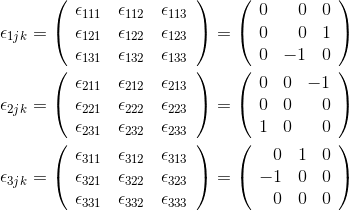Eigenvalues and Eigenvectors
Let A be the square matrix of a linear transformation. Wenn a vector v exists (v ≠ 0)
that is unchanged or is only changed in length when v is
multipied with the matrix, then this vector v is an eigenvektor of the matrix A. The scaling factor λ of the
vector is called an eigenvalue of the matrix A.
Eigenvalue Equation:
With A being a square matrix and λ being eigenvalues (scalar values) and v being eigenvector.
Example:
Characteristic Polynomial
Rearanging the Eigenvalue Equation gives:
Example:
Building the determinate of the first term in this expression will give in the characteristic polynomial CPA(λ)
With the help of the characteristic polynomial it is possible to compute the eigenvalues of a matrix.
Example:
Let A be a 2*2 matrix
In the case of a 2*2 matrix the charactaristical polynomial CPA(λ) can be written in the following form:
CPA(λ) = λ2 - trace(A)λ +det(A);
A trace is the sum of the diagonal elements of a matrix.
The solutions of this quadratic equation are the eigenvalues λ.
A general quadratic equation:
has two solutions:
for the characteristic polynomial CPA(λ) of a 2*2 matrix we have:
p = -(a22+a11) = -trace(A)
q = a11a22 - a12a21 = det(A)
From this we get the following two eigenvalues λ1,2
In the case of a 2*2 matrix A we have the following two eigenvalues expressed with the trace and the
determinate of the matrix A:
Example:
trace(A) = -6+5 = -1
det(A) = -6*5 - 3*4 = -42
CPA(λ) = λ2 + λ - 42 = 0;
Calculating the eigenvalues λ1,2
λ1 = (-1 + sqrt(1 + 4*42))/2 = (-1 +13)/2 = 12/2 = 6
λ2 = (-1 - sqrt(1 + 4*42))/2 = (-1 -13)/2 = -14/2 = -7
Calculating the Eigenvectors
Eigenvector for λ1=6;
Linear independent Eigenvectors
Eigenvectors that belong to different eigenvalues are linear independent.
Eigenvalues and Eigenvectors in Similar Matrices
A matrix B is similar to a matrix A if an invertible matrix P exists that defines B with B = P-1AP.
An n×n matrix A is similar to diagonal matrix L, if A has n linear independent eigenvectors.
The diagonal elements of L are the eigenvalues. The eigenvectors are the column vectors of P.
Example:
Characteristic Polynomials of Similar Matrices
Similar matrices have the same characteristic polynomial.
The converse however is not true in general. Two matrices with the same characteristic polynomial need not to be similar.
The matrix A and its transposed have the same characteristic polynomial.
Eigenvalues of a Triangular Matrix
If A is a triangular matrix, then the eigenvalues of A are the diagonal elements of A.


 English
English

















